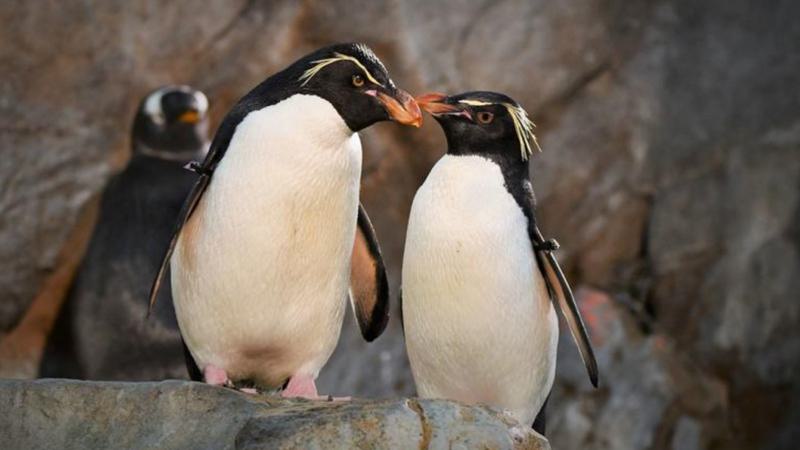The hatching was the result of a breeding recommendation by the Association of Zoos and Aquariums Southern Rockhopper Species Survival Plan, a program to manage a genetically healthy population of southern rockhopper penguins in North American zoos.
Her Name is Opal!
The Saint Louis Zoo asked for the public's help in choosing a name for the penguin chick from four potential names selected by the bird keepers. The results were announced on Zoo social media channels on March 3, 2021.
The winning name is Opal. Out of 36,620 votes cast, Opal received 16,806 of them, or 45.89 percent. Runner-up was Pebbles (9,301 votes), followed by Luna (5,847 votes) and Lumi (4,666 votes).
This chick has a remarkable hatch story, which involves the biological and foster parent penguins, and the skilled, dedicated bird care team at the Zoo. See Opal's story, video and photos at stlzoo.org/rockhopperchick (also copied below).
Soon the chick will be reintroduced to her rockhopper family and other penguins in their public habitat at Penguin & Puffin Coast.
Remarkable Hatch Story
On December 11, 2020, a female southern rockhopper penguin hatched at Penguin & Puffin Coast. This is the first successful hatch of this species at the Zoo in 11 years. Efforts to successfully incubate and hatch this chick required careful planning, great skill and expertise from the care teams in the Bird Department.
The chick's journey began when mom Star, age 18, laid an egg in a nest full of rocks and grasses carefully built by dad Rocky, age 18.
In the past, Star and Rocky had some difficulty successfully incubating eggs on their own, so the bird care team decided to move this egg to an artificial incubator at the Bird House to increase its chances of survival. Keepers gave Star and Rocky a temporary "dummy" egg so they could continue to practice incubating.
For 32 days, keepers monitored the chick's progress during incubation. Every three days, the egg was weighed and briefly examined with a bright light to see the embryo and vessels inside.
To make sure the chick was in the correct position to hatch, the Zoo veterinary team took the chick's first-ever picture using X-rays. Keepers were able to see that the chick was positioned correctly for hatching and had all the correct anatomy like spine, wings and feet.
Foster Parents
When the chick first started to break through its shell, the bird care team knew that it was time to place the egg under the parents. While Star and Rocky had made a wonderful nest, it was located right above open water and much too dangerous for a wiggling chick. The egg was instead carefully placed in the nest of another pair of southern rockhopper penguins — a female also named Rockie, age 25, and a male named Buddha, age 13 — who were nesting in a much safer location. They would become the chick's foster parents.
Rockie and Buddha had produced their own egg, too, around the same time, but it was not fertile. Over the next 48 hours, the chick wiggled and peeped to alert the foster parents that it was making its way out. Once the chick was fully out of the egg, the foster parents eagerly fed the chick around the clock.
The chick's biological parents, Star and Rocky, remain nearby in the same habitat, so the chick will grow up knowing them as part of the larger colony. We are hopeful that each pair will someday successfully produce and rear their own chicks.
Behind the Scenes
Transitioning the family to the behind-the-scenes area of Penguin & Puffin Coast is the first step in acclimating the young chick to keepers while giving the birds a free space for the chick to try out its newfound hopping legs. Penguin chicks are adventurous, and the open water can be quite dangerous for them. The chick's down is warm, but not waterproof, so a slip into the water can chill the chick very quickly.
In the private, behind-the-scenes area, our southern rockhopper chick is weighed every three days and keepers make note of daily milestones, such as venturing out from nest, reduction in begging for food from mom and dad, and changes in feathers and coloration, especially the growth of the iconic yellow feathers around its eyes.
At this stage in the chick's development, mom and dad will leave the chick for longer periods of time to take care of other penguin duties, like swimming and eating. This time away gets longer and longer, and eventually, the parents will officially wean the chick, and keepers will step in to transition the chick to eating whole fish. Social company is important, so the chick gets to spend its days with other penguins like rockhopper Aunt Teresa or gentoo Aunt Trouble.
Penguin & Puffin Coast
When the bird care team sees that the chick is ready, at around 3 months old, they will reintroduce her to her rockhopper family and the rest of the penguins in the public habitat at Penguin & Puffin Coast.
MEDIA CONTACTS:
Saint Louis Zoo 314/781-0900
Billy Brennan, 314/646-4633, Brennan@stlzoo.org
Christy Childs, 314/646-4639, Childs@stlzoo.org
Mike De Pope, 314/646-4703, DePope@stlzoo.org


